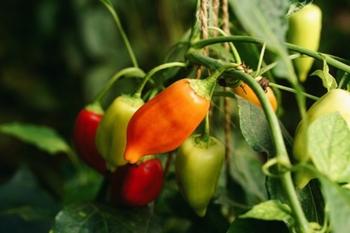Peppers
-
Scientific NameCapsicum annum
-
General InformationMany pepper varieties exist, including sweet (bell, banana) and spicy (Anaheim, cayenne, jalapeño, serrano). Chile peppers are smaller, longer, thinner, and more tapered than sweet peppers. Peppers are native perennials in Central and South America but they are grown as annuals here. Capsaicin is used as a food spice, circulatory stimulant, pain killer, insecticide/fungicide, animal repellent and law enforcement. Red peppers have twice as much vitamin C than green or yellow varieties.
 Photo: Piqsels
Photo: Piqsels -
When to Plant
Plant seedlings April through June in northern Marin and May through mid-June in southern Marin. Peppers are easier to grow from seedlings or starts than from seeds, as seeds need 6 to 10 weeks to grow in a greenhouse or hotbed exposed to sunlight. The ideal germination temperature is 70 to 85 degrees during the day and above 55 degrees at night. It is best to plant seedlings when daytime temperatures are 65 to 85 degrees and nighttime temperatures are at least 60 degrees.
-
Planting
Don’t plant where peppers, tomatoes, potatoes, or eggplants have been grown in the past 3 years. Plant in full sun area. Before planting, amend the soil with a nitrogen-rich aged manure or compost. Select seedlings 4 to 6 inches tall without flowers or fruit on them. Plant 12 to 24 inches apart and pinch the tips to promote more branching and fruit. Don’t handle the stems when planting.
-
Soil Requirements
The soil pH should be 6.5 to 7.0 with rich balanced nutrition and good drainage.
-
Water Requirements
Peppers require moderate, even watering. Water stress causes blossoms and developing fruit to drop and soggy conditions reduces fruit set. Where temperatures regularly exceed 90 degrees, peppers can benefit from light shade in the afternoon.
-
Fertilizing
Side dress with fish emulsion, compost tea, or aged manure at fruit set.
-
Pollination
Peppers are mostly self-pollinated; hot peppers are more likely to cross-pollinate. Flowers typically develop when plants have produced about 10 nodes on the stem. The first flowers may drop off without setting fruit if nighttime temperatures are too cool. If pollination is a problem, you can hand pollinate using a small brush.
-
Harvesting
Pick peppers when they quit enlarging and cut the stems to avoid damage to the plant. They may be big enough to pick in July or August, but harvesting may be delayed in foggy areas of southern Marin. Plants may bear fruit through November if there are no heavy rains. Most peppers turn from green (unripe) to yellow, orange, or red when fully ripe (8 to 10 weeks). In cooler climates, bell peppers won’t get as big or sweet and hot peppers won’t get as hot.
You can remove small fruit near the end of the season to channel energy into the remaining ones to get bigger fruit. Ripening keeps the plant from setting new fruit, so you may prefer to stick with green peppers to get more of them.
-
Storage
Keep stored in the refrigerator for up to one week, longer if they are kept dry. Do not store in the same bin as apples and bananas because they may be injured from ethylene gas, which apples and bananas release.
-
Good Varieties for Marin
Select early varieties (60 to 70 days from transplanting) and disease resistant plants. Recommended varieties for Marin include California Wonder, Gypsy F1, Ace F1, Sweet Banana, Minibell, Early Jalapeño, Senorita F1, Dulce F1, Cherry Bomb F1, and Hungarian Hot Wax. There are many other varieties available in our local nurseries, including heirlooms.
-
Helpful Tips
Use cover cloth overhead and black plastic on the ground to promote warmth and earlier fruiting. Choose varieties carefully for microclimatic conditions in your garden. Seedlings with flowers or fruit are less likely to develop good root systems after transplanting. Be aware that pepper roots can be deep, as much as 4 feet for some varieties.
-
Common Problems
Avoid tomato late blight by not watering overhead or planting too close together, and by removing discolored and misshapen fruit. If sweet peppers don’t get enough water after flowering, or the soil lacks micronutrients, they can get blossom end rot. If leaves turn yellow and drop, add magnesium by making a foliar spray using one teaspoon of Epsom salt per pint of water.
-
Pests- Diseases & More
Peppers may be susceptible to aphids, cabbage loopers, corn earworms and slugs, but these insects are likely to attack other garden plants before becoming a problem for peppers. Learn more.

